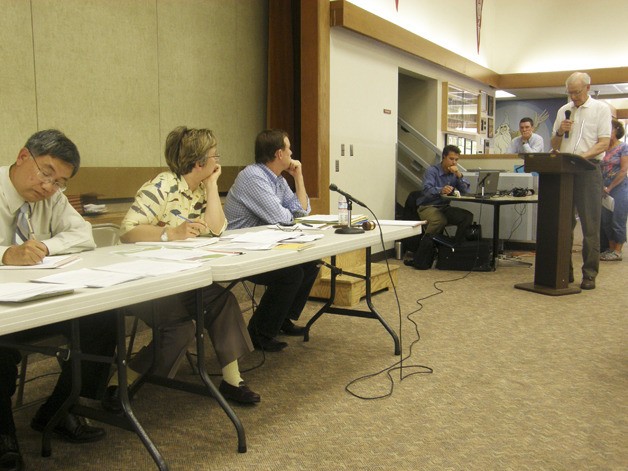Supporters of Pacific Raceways like Jennifer Nowland said its proposed expansion would be good for the community, kicking out $15 million to the local economy and adding more than 1,000 badly-needed jobs.
Critics like track neighbor John Bennett countered that it would ramp up the noise and basically add more of the stuff that already drives many people bats about the 50-year-old raceway between Kent and Auburn.
“I bought my home under one set of circumstances, and since then the raceway has tripled the number of events, it has added a Go-Kart track, it is adding a new drag (strip),” Bennett said. “The drag (strip) will be north-south, instead of east-west. I’m north of the track. Guess what that’s going to do to my noise factor?”
King County Councilman Pete von Reichbauer heard from both sides during the public meeting at Lakeview Elementary last Thursday evening.
At issue was a King County ordinance that proposes to make the expansion a “demonstration project,” a new planning category answering the County’s need for a master planning process for large, multi-year, complex, multi-phase commercial property. The category would allow King County to study regulations and how well they work on a project-specific basis to determine if there are changes that should be applied to the code after the demonstration project is done.
As such, a demonstration project carries implications not only for Pacific Raceways but for other large-scale projects in the future.
The new ordinance succeeds earlier legislation that had aimed at creating a “special overlay district” for Pacific Raceways. County officials abandoned the SOD after critics, most of them raceway neighbors, testified that it lacked a comprehensive review process and offered little possibility for community input.
Rick Bautista, senior policy analyst for the KCC, agreed that that criticism was valid.
“Looking at the special district overlay legislation, that was absolutely true criticism, and that’s one of the reasons we quickly came away from that,” Bautista told the audience.
The legislation tries to answer critics’ concerns, determining how the county reviews the Pacific Raceways application and giving the community more of a voice. It has nothing to do, however, with the Pacific Raceways’ actual application, which proponents have not yet submitted.
Don Huling, a track neighbor and critic, said that the track’s owners have routinely flouted a 25-year-old conditional use permit (CUP) that limits the raceway’s hours of operation and noise levels.
“It — the new ordinance — attempts to give special rights to a developer who doesn’t deserve them, based on his previous violations of the CUP that he signed up for,” Huling said. “He has found ways of slithering around doing all the right things for his neighbors — us.”
“What you have here is a developer who hasn’t adhered to the regulations,” Bennett said. “They’re not supposed to operate at 11:40 at night, that’s all been specified since 1985 or thereabouts. This developer hasn’t proven he can be trusted. … This is about enforcing what is there.”
Bautista said the CUP is subject to interpretation, so the proposed ordinance calls for a development agreement that clearly states what can and can’t be done and when at the raceway. It also sets development conditions.
At the moment, the King County code contains no noise caps for raceways in King County, but the development agreement would include noise levels for particular types of racing vehicles.
For the first time, von Reichbauer said, King County will take a critical role in the ongoing monitoring and implementation of such a large development project.
“That is not something we do now,” von Reichbauer said. “The Council considers that, because we have people who have expressed a lot of frustration about the ability or willingness of the Department of Development Services (DDS) to apply the laws as people think they should be applied, the ordinance would allow Council to step in at a certain point in the process to make sure laws are complied with.”
The new ordinance also adjusts timelines for project review, which John Starbard, head of the Department of Development and Environmental Services (DDES) — said had been too short. The DDES is the permitting agency for unincorporated King County.
Nowland, who lives next to the track, spoke for the expansion.
“The benefits of this improvement project clearly outweigh the negative impacts. … Noise mitigation, traffic mitigation, surface ground water mitigation, a business park that can provide possibly a thousand jobs, upgrades to the road course that will allow three to four national road course events per year. With noise and traffic mitigation, the community impact would only be positive,” Nowland said.
“This is not about having the raceway go away,” said Bennett. “It’s about protecting the rights of the raceway and the rights of the homeowners who moved here, knowing it was here, knowing there was a conditional use permit in place to protect the rights of everybody.”
The King County Council’s Environment and Transportation Committee held a public hearing on the ordinance Tuesday at the King County Courthouse, adding a requirement for an environmental impact statement. While members did not vote on the ordinance, members expect to do so next Tuesday in Seattle.


